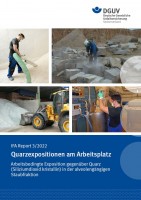IFA Report 03/2022: Exposure to quartz at the workplace – Work-related exposure to quartz (crystalline silicon dioxide) from the respirable dust fraction
inkl. MwSt. zzgl. Versandkosten
Versandkostenfreie Lieferung!
Sofort versandfertig, Lieferzeit ca. 1-3 Werktage
- Ausgabedatum: 2023.03
- Herausgeber: DGUV
- Seitenzahl: 155
- Format: DIN A4
- Sprache: Englisch
- Webcode: p022363
Quartz is used as an agent or is released, in the form of quartz dust, in a wide range of work processes. Despite technical progress and considerable efforts to reduce exposure to dust, exposure to respirable quartz dust at workplaces remains an important issue. This is evidenced by the number of quartz dust measurements conducted as part of the MGU measurement system for exposure assessment of the German Social Accident Insurance Institutions, which currently stands at around 1,200 measurements per year in 600 different work areas. In 2006, around 100,000 measured values for respirable dust containing quartz were statistically evaluated for BGIA Report 8/2006 “Exposure to quartz at the workplace”.
This new edition of BGIA Report 8/2006 provides a synoptic representation of occupational exposure to respirable dust containing quartz. For this purpose, over 15,100 quartz measurements carried out within the MGU measurement system from January 2005 to December 2016 – which were documented in the MEGA exposure database of the Institute for Occupational Safety and Health of the German Social Accident Insurance, IFA (MEGA stands for Measurement data relating to workplace exposure to hazardous substances) – were sorted into different industries and work areas and statistically evaluated. The data are supplemented with explanations about activities that are subject to exposure, about work processes, about the implementation of protective measures and about the state of the art. IFA Report 4/2022 “Exposure to quartz at the workplace” can be used as a basis for guiding preventative measures, for exposure monitoring and for determining quartz dust exposures during the process of reporting suspected occupational diseases. However, it also makes an important contribution to the discussion among expert committees within the context of the further development of the technical rules for hazardous substances.


